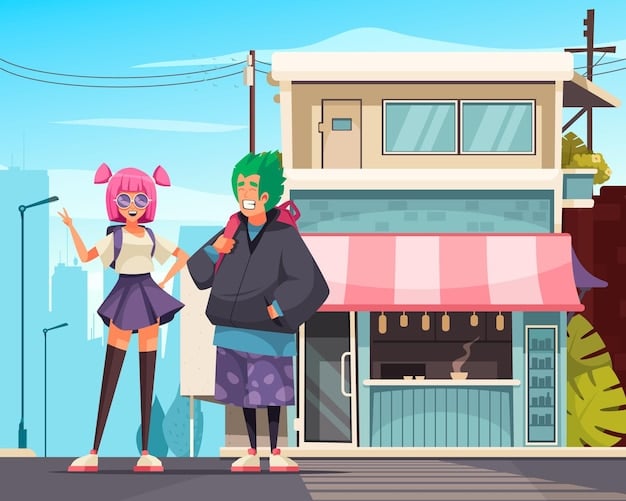Shonen Jump Licensing Deals: US Brand Collaborations

Shonen Jump’s licensing deals extend far beyond manga and anime, forging exciting collaborations with US brands across various industries, bringing beloved characters and stories to everyday products.
The world of Shonen Jump’s licensing deals is constantly expanding, with exciting new collaborations emerging with US brands. These partnerships bring iconic characters and storylines from beloved manga and anime series to a wide range of products and experiences, captivating fans across the United States.
Exploring Shonen Jump’s Licensing Universe
Shonen Jump, the iconic manga anthology, has become a global phenomenon. Its influence extends far beyond the pages of its magazines, penetrating popular culture through various licensing deals. These collaborations bring the exciting worlds of Shonen Jump characters to life in unexpected and engaging ways.
Understanding the scope of these licensing deals provides insight into Shonen Jump’s strategic partnerships and the impact it has on the US market. From apparel to collectibles, the possibilities seem limitless.
The Power of Brand Licensing
Brand licensing is a strategic alliance where a company (licensor) grants another company (licensee) the right to use its intellectual property (IP), such as characters, logos, or trademarks. This allows the licensee to create products or services that leverage the recognition and appeal of the licensor’s brand.
- Increased Brand Awareness: Licensing deals expose a brand to new audiences and markets.
- Revenue Generation: Royalties from licensing agreements provide a steady income stream.
- Market Expansion: Licensing can help a brand enter new product categories without significant investment.
- Enhanced Brand Image: Strategic collaborations can elevate a brand’s image and appeal.
Shonen Jump has successfully utilized brand licensing to amplify its presence in the US and beyond, solidifying its position as a cultural powerhouse.
These licensing adaptations increase revenue and brand awareness, and create unique, valuable products.
Current Trends in Shonen Jump Collaborations
The landscape of Shonen Jump’s licensing deals is ever-evolving, adapting to emerging trends and consumer preferences. Understanding these current trends is crucial for grasping the direction these collaborations are heading.
Staying informed about these developments allows fans and industry observers to anticipate future partnerships and the innovative products they may yield.
Focus on Experiential Marketing
Experiential marketing creates memorable moments for consumers by immersing them in a brand’s world. Shonen Jump’s licensing deals are increasingly incorporating experiential elements, such as pop-up shops, themed events, and interactive installations.

For example, a recent collaboration with a popular streetwear brand featured a pop-up shop with exclusive merchandise and interactive displays that allowed fans to step into the world of their favorite Shonen Jump series. These experiences create a stronger connection between fans and the brand. Beyond pop-up shops, collaborative restaurant ventures have gained traction, offering themed menus, immersive decor, and limited-edition collectibles, enhancing the interactive fan experience.
Sustainability and Ethical Sourcing
Consumers are increasingly concerned about the environmental and social impact of their purchases. Shonen Jump’s licensing partners are responding by prioritizing sustainability and ethical sourcing in their products and practices. This includes using eco-friendly materials, reducing waste, and ensuring fair labor practices.
Consumers are more attuned to corporate responsibility, with many prepared to support brands aligning with their values.
By embracing sustainability and ethical sourcing, Shonen Jump and its partners demonstrate a commitment to responsible business practices that resonate with conscious consumers.
Spotlight on Key US Brand Partnerships
Several key US brand partnerships stand out in the realm of Shonen Jump’s licensing deals. These collaborations showcase the diversity and creativity of these partnerships.
Examining these specific examples reveals the strategies and benefits that both Shonen Jump and its US brand partners derive from these arrangements.
Nike and Naruto
The collaboration between Nike and Naruto brought the iconic anime series to the world of sportswear. The collection featured apparel and footwear adorned with Naruto-themed designs, appealing to both anime fans and sneakerheads. This partnership combined the appeal of a global sportswear brand with the cultural relevance of a beloved anime series, resulting in a successful and highly sought-after collection.
Uniqlo and Shonen Jump
Uniqlo has consistently partnered with Shonen Jump to release UT (Uniqlo T-shirts) collections featuring various popular series. These collections offer affordable and stylish apparel that allows fans to express their love for their favorite characters. The collaboration has been a long-standing success, with new collections released regularly to coincide with new anime seasons or manga milestones. The regular releases of themed collections has sustained brand awareness and popularity.
Hot Topic and My Hero Academia
Hot Topic, a retail chain specializing in pop culture merchandise, has partnered with My Hero Academia to offer a wide range of apparel, accessories, and collectibles. The collaboration provides fans with a convenient way to access merchandise featuring their favorite characters and symbols from the series. These products also make great collectible items for true fans.
These key US brand partnerships highlight the power of collaboration in bringing Shonen Jump’s characters and stories to life in tangible and engaging ways for fans across the United States.
Navigating Licensing Agreements: Key Considerations
Successfully navigating licensing agreements is crucial for both Shonen Jump and its US brand partners. These agreements outline the terms and conditions of the collaboration, ensuring that both parties are protected and aligned in their goals.
Understanding the key considerations involved in these agreements is essential for maximizing the benefits of these partnerships.
Intellectual Property Rights
Protecting intellectual property rights is paramount in any licensing agreement. This includes clearly defining the scope of the licensed IP, specifying the permitted uses, and establishing mechanisms for enforcing these rights. Shonen Jump and its partners must ensure that their IP is protected from unauthorized use or infringement.
- Clear Definition of IP: Specify exactly what IP is being licensed (characters, logos, trademarks, etc.).
- Permitted Uses: Outline the specific products or services that the licensee is authorized to create.
- Enforcement Mechanisms: Establish procedures for monitoring and addressing IP infringement.
By prioritizing the protection of intellectual property rights, Shonen Jump and its partners can safeguard the value of their brands and ensure the long-term success of their collaborations.
Financial Terms and Royalties
The financial terms of a licensing agreement, including royalties, are critical considerations. Royalties are typically calculated as a percentage of the licensee’s sales. The royalty rate should be fair and reflect the value of the licensed IP. In addition to royalties, licensing agreements may also include upfront fees or minimum guarantee payments.
The success of the collaboration depends on mutually beneficial financial arrangements.
By carefully negotiating financial terms and royalties, Shonen Jump and its partners can ensure that their licensing agreements are financially sustainable and contribute to their overall business objectives.

Future Trends in Shonen Jump Licensing
Looking ahead, the future of Shonen Jump’s licensing deals promises exciting new developments and opportunities. Several emerging trends are poised to shape the landscape of these collaborations.
Staying abreast of these trends will enable Shonen Jump and its US brand partners to capitalize on new opportunities and maintain a competitive edge.
Expansion into Metaverse and NFTs
The metaverse and NFTs (non-fungible tokens) are rapidly gaining traction as new platforms for brand engagement. Shonen Jump is exploring opportunities to leverage these technologies to create virtual experiences and digital collectibles featuring its characters and series. This could involve creating virtual worlds where fans can interact with their favorite characters or offering NFTs as rewards for engaging with Shonen Jump content.
AI-Powered Personalization
Artificial intelligence (AI) is being used to personalize consumer experiences in various industries. Shonen Jump could leverage AI to tailor licensing deals to individual consumer preferences. This could involve using AI to analyze data and identify potential product collaborations that align with specific demographic groups or interests. Also, consider AI to anticipate consumer trends.
Direct-to-Consumer (DTC) Licensing
Direct-to-consumer (DTC) licensing involves Shonen Jump directly selling licensed products to consumers through its own online channels. This allows Shonen Jump to retain greater control over the brand experience and capture a larger share of the revenue. DTC licensing could involve creating exclusive merchandise collections or offering subscription boxes featuring curated Shonen Jump products.
By exploring these future trends, Shonen Jump can ensure that its licensing deals remain innovative and relevant in the ever-evolving landscape of entertainment and consumer goods.
Maximizing the Impact of Collaborations
To maximize the impact of Shonen Jump’s licensing deals, both Shonen Jump and its US brand partners must implement effective strategies for promotion and engagement.
These strategies can significantly enhance the visibility and appeal of licensed products, driving sales and strengthening brand loyalty.
Social Media Campaigns
Social media is a powerful tool for promoting licensing deals and engaging with fans. Shonen Jump and its partners should launch comprehensive social media campaigns that leverage the popularity of their characters and series.
- Engaging Content: Share behind-the-scenes content, sneak peeks of new products, and interactive polls or quizzes.
- Influencer Marketing: Partner with relevant influencers to promote licensed products to their followers.
- Contests and Giveaways: Host contests and giveaways to generate excitement and increase brand awareness.
By effectively utilizing social media, Shonen Jump and its partners can reach a wide audience and build a strong community of fans.
Cross-Promotion
Cross-promotion involves promoting licensed products across multiple channels, including online, in-store, and through traditional media. Shonen Jump and its partners should coordinate their marketing efforts to ensure that their messages are consistent and reach a broad audience.
Effective communication helps solidify marketing plans.
By implementing effective cross-promotion strategies, Shonen Jump and its partners can maximize the visibility of their licensed products and drive sales.
| Key Point | Brief Description |
|---|---|
| 🤝 US Brand Partnerships | Shonen Jump collaborates with Nike, Uniqlo, and Hot Topic. |
| ✨ Experiential Marketing | Pop-up shops and themed events enhance fan engagement. |
| 🌱 Sustainability Focus | Emphasis on eco-friendly materials and ethical sourcing. |
| 🌐 Metaverse Expansion | Exploring virtual experiences and NFTs for fans. |
FAQ
▼
Brand licensing occurs when a company grants another the rights to use its intellectual property. The licensee creates products using the licensor’s brand, benefiting from the recognition and appeal. This is a great way to create brand awareness.
▼
Experiential marketing immerses consumers in a brand’s world. Recent partnerships have brought successful pop-up shops with exclusive merchandise, creating memorable moments for fans and establishing greater brand affinity.
▼
NFTs, or non-fungible tokens, are unique digital assets. Shonen Jump has been exploring NFTs as a source of rewards and promotional opportunities, and as a way to engage fans on a digital playing field.
▼
Royalty rates are influenced by the brand’s popularity, the product, and market conditions. Both licensors and licensees must agree on reasonable rates to guarantee fair income and the long-term viability of collaborations.
▼
DTC licensing allows Shonen Jump to directly supply customers through various online channels. Doing so enables Shonen Jump to manage brand experience. Direct-to-Consumer licensing presents subscription boxes for a unique connection with its fans.
Conclusion
Shonen Jump’s licensing deals with US brands represent a dynamic and evolving landscape of collaborations. These partnerships bring beloved characters and series to life in innovative ways, captivating fans across the United States. By understanding the current trends, navigating licensing agreements effectively, and implementing strategic promotion and engagement tactics, Shonen Jump and its partners can maximize the impact of these collaborations and continue to delight fans for years to come.





